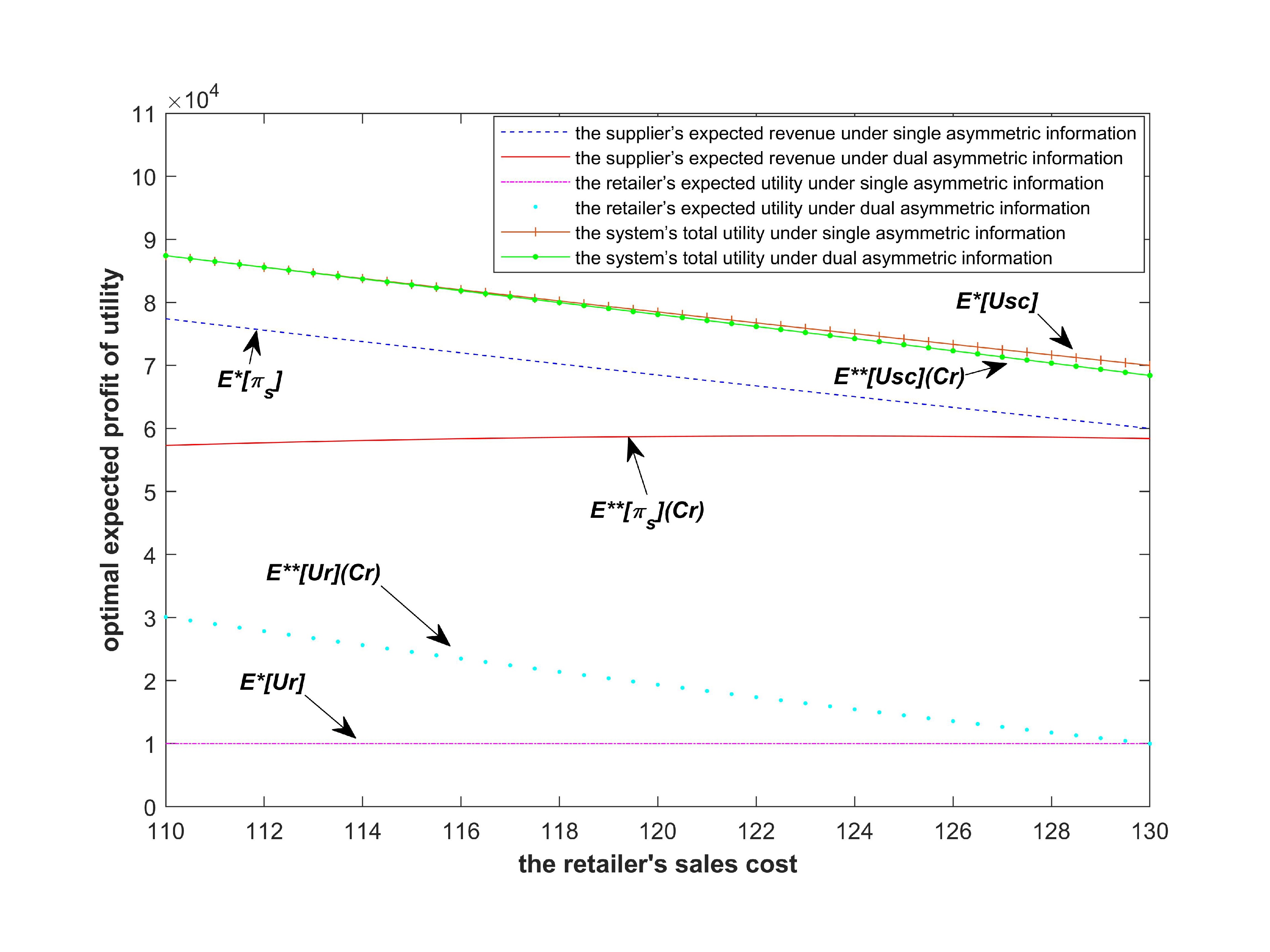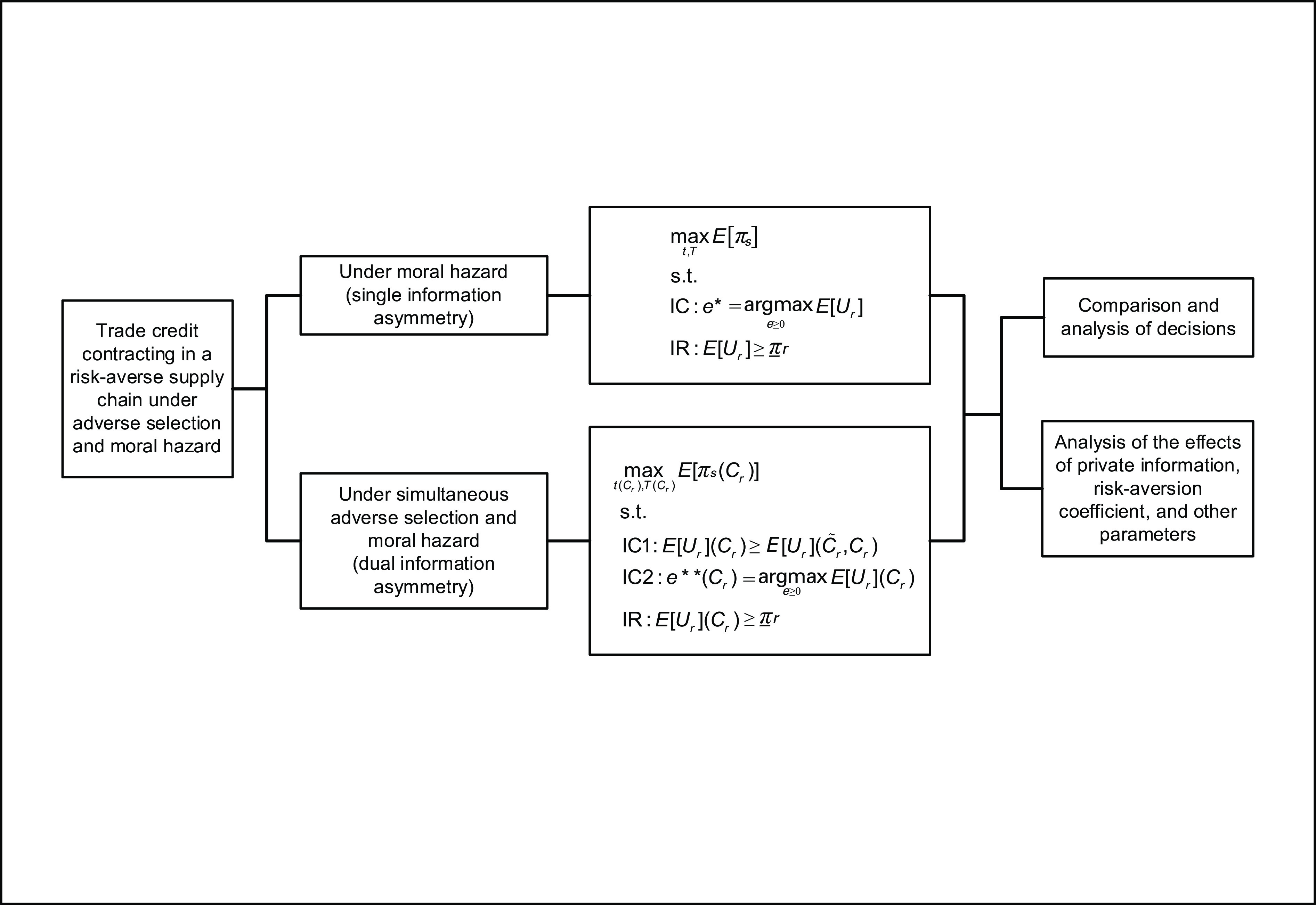
ISSN 0253-2778
CN 34-1054/N
Trade credit, as an effective tool for integrating and coordinating material, information, and financial flows in supply chain management, is becoming increasingly widespread. We explore how a manufacturer can design optimal trade credit contracts when a risk-averse retailer hides its sales cost information (adverse selection) and selling effort level (moral hazard). We develop incentive models for a risk-averse supply chain when adverse selection and moral hazard coexist, which are then compared with the results under single information asymmetry (moral hazard). Moreover, we analyze the effects of private information and risk-aversion coefficient on contract parameters, selling effort level and the profit or utility of the supply chain. The study shows that when the degree of retailer’s risk aversion is within a certain range, reasonable trade credit contracts designed by the manufacturer can effectively induce the retailer to report its real sales cost and encourage it to exert appropriate effort. Furthermore, we find that the optimal trade credit period, optimal transfer payment, and retailer’s optimal sales effort level under dual information asymmetry are less than under single information asymmetry. Numerical analysis are conducted to demonstrate the effects of the parameters on decisions and profits.

The overall framework of our delivery selection model.
| [1] |
Seifert D, Seifert R W, Protopappa-Sieke M. A review of trade credit literature: Opportunities for research in operations. Eur. J. Oper. Res., 2013, 231 (2): 245–256. DOI: 10.1016/j.ejor.2013.03.016
|
| [2] |
Chen S C, Teng J T. Inventory and credit decisions for time-varying deteriorating items with up-stream and down-stream trade credit financing by discounted cash flow analysis. Eur. J. Oper. Res., 2015, 243 (2): 566–575. DOI: 10.1016/j.ejor.2014.12.007
|
| [3] |
Wang K, Zhao R, Peng, J. Trade credit contracting under asymmetric credit default risk: Screening, checking or insurance. Eur. J. Oper. Res., 2018, 266 (2): 554–568. DOI: 10.1016/j.ejor.2017.10.004
|
| [4] |
Zhong Y G, Zhou Y W. Improving the supply chain’s performance through trade credit under inventory-dependent demand and limited storage capacity. Int. J. Prod. Econ., 2013, 143 (2): 364–370. DOI: 10.1016/j.ijpe.2012.07.013
|
| [5] |
Tsao Y C. Channel coordination under two-level trade credits and demand uncertainty. Appl. Math. Comput., 2017, 52: 160–173. DOI: 10.1016/j.apm.2017.07.046
|
| [6] |
Sarkar B, Ahmed W, Kim N. Joint effects of variable carbon emission cost and multi-delay-in-payments under single-setup-multiple-delivery policy in a global sustainable supply chain. J. Clean. Prod., 2018, 185: 421–445. DOI: 10.1016/j.jclepro.2018.02.215
|
| [7] |
Wang Z H, Qi L, Zhang Y, et al. A trade-credit-based incentive mechanism for a risk-averse retailer with private information. Comput. Ind. Eng., 2021, 154: 107101. DOI: 10.1016/j.cie.2021.107101
|
| [8] |
Xie G, Wang S, Lai K K. Quality investment and price decision in a risk-averse supply chain. Eur. J. Oper. Res., 2011, 214 (2): 403–410. DOI: 10.1016/j.ejor.2011.04.036
|
| [9] |
Wu M, Zhu S X, Teunter R H. A risk-averse competitive newsvendor problem under the CVAR criterion. Int. J. Prod. Econ., 2014, 156 (5): 13–23. DOI: 10.1016/j.ijpe.2014.05.009
|
| [10] |
Yang H L, Zhuo W Y, Shao L S, et al. Mean-variance analysis of wholesale price contracts with a capital-constrained retailer: Trade credit financing vs. bank credit financing. Eur. J. Oper. Res., 2021, 294: 525–542. DOI: 10.1016/j.ejor.2021.01.042
|
| [11] |
Wang Z H, Liu S F. Supply chain coordination under trade credit and quantity discount with sales effort effects. Math. Probl. Eng., 2018, 2018: 2190236. DOI: 10.1155/2018/2190236
|
| [12] |
Haley C W, Higgins R C. Inventory policy and trade credit financing. Manage. Sci., 1973, 20 (4): 464–471. DOI: 10.1287/mnsc.20.4.464
|
| [13] |
Goyal S K. Economic order quantity under conditions of permissible delay in payments. J. Oper. Res. Soc., 1985, 36 (4): 1069–1069. DOI: 10.1057/jors.1985.56
|
| [14] |
Huang Y F. Optimal retailer’s ordering policies in the EOQ model under trade credit financing. J. Oper. Res. Soc., 2003, 54 (9): 1011–1015. DOI: 10.1057/palgrave.jors.2601588
|
| [15] |
Wu J, Alkhateeb F B, Teng J T. Inventory models for deteriorating items with maximum life time under downstream partial trade credits to credit-risk customers by discounted cash-flow analysis. Int. J. Prod. Econ., 2016, 171 (1): 105–115. DOI: 10.1016/j.ijpe.2015.10.020
|
| [16] |
Cárdenas-Barrón L E, Shaikh A A, Tiwari S, et al. An EOQ inventory model with nonlinear stock dependent holding cost, nonlinear stock dependent demand and trade credit. Comput. Ind. Eng., 2018, 139: 105557. DOI: 10.1016/j.cie.2018.12.004
|
| [17] |
Abad P L, Jaggi C K. A joint approach for setting unit price and the length of the credit period for a seller when end demand is price sensitive. Int. J. Prod. Econ., 2003, 83 (2): 115–122. DOI: 10.1016/s0925-5273(02)00142-1
|
| [18] |
Wang W C, Teng J T, Lou K R. Seller’s optimal credit period and cycle time in a supply chain for deteriorating items with maximum lifetime. Eur. J. Oper. Res., 2014, 232 (2): 315–321. DOI: 10.1016/j.ejor.2013.06.027
|
| [19] |
Pramanik P, Maiti M K, Maiti M. Three level partial trade credit with promotional cost sharing. Applied Soft Computing, 2017, 58: 553–575. DOI: 10.1016/j.asoc.2017.04.013
|
| [20] |
Jaber M Y, Osman I H. Coordinating a two-level supply chain with delay in payments and profit sharing. Comput. Ind. Eng., 2006, 50: 385–400. DOI: 10.1016/j.cie.2005.08.004
|
| [21] |
Luo J W. Buyer–vendor inventory coordination with credit period incentives. Int. J. Prod. Econ., 2007, 108 (12): 143–152. DOI: 10.1016/j.ijpe.2006.12.007
|
| [22] |
Yang S, Hong K S, Lee C L. Supply chain coordination with stock-dependent demand rate and credit incentives. Int. J. Prod. Econ., 2014, 157 (1): 105–111. DOI: 10.1016/j.ijpe.2013.06.014
|
| [23] |
Lee C H, Rhee B D. Trade credit for supply chain coordination. Eur. J. Oper. Res., 2011, 214 (1): 136–146. DOI: 10.1016/j.ejor.2011.04.004
|
| [24] |
Heydari J, Rastegar M, Gloc C H. A two-level delay in payments contract for supply chain coordination: The case of credit-dependent demand. Int. J. Prod. Econ., 2017, 191: 26–36. DOI: 10.1016/j.ijpe.2017.05.004
|
| [25] |
Zou X X, Tian B. Retailer’s optimal ordering and payment strategy under two-level and flexible two-part trade credit policy. Comput. Ind. Eng., 2020, 142: 106317. DOI: 10.1016/j.cie.2020.106317
|
| [26] |
Ren D, Lan Y F, Shang C J, et al. Impacts of trade credit on pricing decisions of complementary products. Comput. Ind. Eng., 2020, 146: 106580. DOI: 10.1016/j.cie.2020.106580
|
| [27] |
Babich V, Kouvelis P. Introduction to the special issue on research at the interface of finance, operations, and risk management (iFORM): Recent contributions and future directions. Manufacturing & Service Operations Management, 2018, 20 (1): 1–18. DOI: 10.1287/msom.2018.0706
|
| [28] |
Yang S A, Birge J R. Trade credit, risk sharing, and inventory financing portfolios. Management Science, 2018, 64 (8): 3667–3689. DOI: 10.1287/mnsc.2017.2799
|
| [29] |
Wu D, Zhang B, Baron O. A trade credit model with asymmetric competing retailers. Prod. Oper. Manag., 2019, 28 (1): 206–231. DOI: 10.1111/poms.12882
|
| [30] |
Kouvelis P, Zhao W H. Who should finance the supply chain? Impact of credit ratings on supply chain decisions. Manufacturing & Service Operations Management, 2017, 20 (1): 19–35. DOI: 10.1287/msom.2017.0669
|
| [31] |
Yan N N, He X L. Optimal trade credit with deferred payment and multiple decision attributes in supply chain finance. Comput. Ind. Eng., 2020, 145: 106627. DOI: 10.1016/j.cie.2020.106627
|
| [32] |
Li B, An S M, Song D P. Selection of financing strategies with a risk-averse supplier in a capital-constrained supply chain. Transportation Research Part E: Logistics and Transportation Review, 2018, 118: 163–183. DOI: 10.1016/j.tre.2018.06.007
|
| [33] |
Zhang Y M, Chen W D. Optimal production and financing portfolio strategies for a capital-constrained closed-loop supply chain with OEM remanufacturing. J. Clean. Prod., 2021, 279: 123467. DOI: 10.1016/j.jclepro.2020.123467
|
| [34] |
Luo J W, Zhang Q H. Trade credit: A new mechanism to coordinate supply chain. Oper. Res. Lett., 2012, 40 (5): 378–384. DOI: 10.1016/j.orl.2012.04.008
|
| [35] |
Devalkar S K, Krishnan H. The impact of working capital financing costs on the efficiency of trade credit. Prod. Oper. Manag., 2019, 28 (4): 878–889. DOI: 10.1111/poms.12954
|
| [36] |
Yue X, Liu J. Demand forecast sharing in a dual-channel supply chain. Eur. J. Oper. Res., 2006, 174 (1): 646–667. DOI: 10.1016/j.ejor.2004.12.020
|
| [37] |
Lal R, Srinivasan V. Compensation plans for single- and multi-product salesforces: An application of the Holmstrom-Milgrom model. Management Science, 1993, 39 (7): 777–793. DOI: 10.1287/mnsc.39.7.777
|
| [38] |
Chen F R. Salesforce incentives, marketing information and production inventory planning. Management Science, 2005, 51 (1): 60–75. DOI: 10.1287/mnsc.1040.0217
|
| [39] |
Lariviere M A. A note on probability distributions with increasing generalized failure rates. Oper. Res., 2006, 54 (3): 602–604. DOI: 10.1287/opre.1060.0282
|
| [40] |
Lariviere M A, Porteus E L. Selling to the newsvendor: an analysis of price-only contracts. Manufacturing & Service Operations Management, 2001, 3 (4): 293–305. DOI: 10.1287/msom.3.4.293.9971
|
| [41] |
Lau H S. The newsboy problem under alternative optimization objectives. J. Oper. Res. Soc., 1980, 31 (6): 525–535. DOI: 10.1057/jors.1980.96
|
| [42] |
Çakanyıldırım M, Feng Q, Gan X H, et al. Contracting and coordination under asymmetric production cost information. Prod. Oper. Manag., 2012, 21 (2): 345–360. DOI: 10.1111/j.1937-5956.2011.01258.x
|
| [43] |
Chen K B, Zhao H M, Xiao T J. Outsourcing contracts and ordering decisions of a supply chain under multi-dimensional uncertainties. Comput. Ind. Eng., 2019, 130: 127–141. DOI: 10.1016/j.cie.2019.02.010
|
| [44] |
Myerson R B. Incentive compatibility and the bargaining problem. Econometrica, 1979, 47 (1): 61–73. DOI: 10.2307/1912346
|
| [45] |
Bazaraa M S, Sherali H D, Shetty C M. Nonlinear Programming: Theory and Algorithms. 2nd Edition. New York: Wiley, 1993.
|